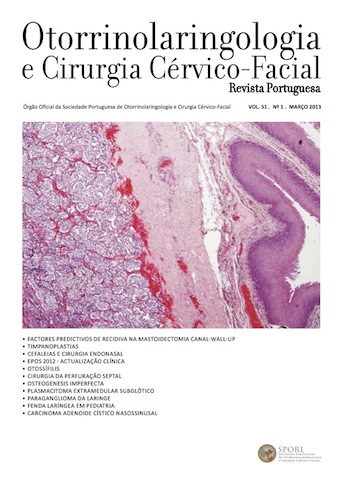Otological malformation in the context of cat's eye syndrome
DOI:
https://doi.org/10.34631/sporl.1087Keywords:
congenital aural atresia, karyotype, hearing lossAbstract
Background and objective: Congenital aural atresia is a congenital defect that occurs in 1 in 10,000 to 15,000 live births. It can occur in isolation or associated with a polymalformative syndrome, including cat eye syndrome .
Clinical case: This is a male born at term with anorectal malformation, bilateral microtia with agenesis of the right external auditive conduct and dysmorphic features are observed. The audiological evaluation performed demonstrates the existence of bilateral moderate-severe conductive hearing loss. The genetic study demonstrates the presence of a trisomy of chromosome 22, a genetic alteration responsible for cat eye syndrome .
Discussion: Cat eye syndrome is a rare disease which presents with ocular coloboma, anal atresia and ear defects. Definitive diagnosis is based on peripheral blood karyotype. Comprehensive patient approach by a multidisciplinary team is essential, however, prognosis is usually good.
Downloads
References
Sharma D, Murki S, Pratap T, Vasikarla M. Cat eye syndrome. BMJ Case Rep. 2014 May 19;2014:bcr2014203923. doi: 10.1136/bcr-2014-203923.
Rosa RF, Mombach R, Zen PR, Graziadio C, Paskulin GA. Clinical characteristics of a sample of patients with cat eye syndrome. Rev Assoc Med Bras (1992). 2010 Jul-Aug;56(4):462-5. doi: 10.1590/s0104-42302010000400021.
Knijnenburg J, van Bever Y, Hulsman LO, van Kempen CA, Bolman GM, van Loon RL. et al. A 600 kb triplication in the cat eye syndrome critical region causes anorectal, renal and preauricular anomalies in a three-generation family. Eur J Hum Genet. 2012 Sep;20(9):986-9. doi: 10.1038/ejhg.2012.43.
Alamer L, Bassant S, Alhazmi R, Alzahrani M. Rare otologic presentation of cat eye syndrome. Ann Saudi Med. 2019 Nov-Dec;39(6):441-443. doi: 10.5144/0256-4947.2019.441.
Kvarnung M, Lindstrand A, Malmgren H, Thastrom A, Jacobson L, Dahl N. et al. Inherited mosaicism for the supernumerary marker chromosome in cat eye syndrome: Inter- and intra-individual variation and correlation to the phenotype. Am J Med Genet A. 2012 May;158A(5):1111-7. doi: 10.1002/ajmg.a.35311.
Belangero SI, Pacanaro AN, Bellucco FT, Christofolini DM, Kulikowski LD, Guilherme RS. et al. Wide clinical variability in cat eye syndrome patients: Four non-related patients and three patients from the same family. Cytogenet Genome Res. 2012;138(1):5-10. doi: 10.1159/000341570.
Xue H, Chen X, Lin M, Lin N, Huang H, Yu A. et al. Prenatal diagnosis and molecular cytogenetic identification of small supernumerary marker chromosomes: analysis of three prenatal cases using chromosome microarray analysis. Aging (Albany NY). 2020 Dec 9;13(2):2135-2148. doi: 10.18632/aging.202220.
Hernández-Medrano C, Hidalgo-Bravo A, Villanueva-Mendoza C, Bautista-Tirado T, Apam-Garduño D. Mosaic cat eye syndrome in a child with unilateral iris coloboma. Ophthalmic Genet. 2021 Feb;42(1):84-87. doi: 10.1080/13816810.2020.1839918.
Jedraszak G, Receveur A, Andrieux J, Naepels P, Mathieu-Dramard M, Bremond-Gignac D. et al. A severe prenatal presentation of Cat Eye Syndrome. Clin Dysmorphol. 2013 Oct;22(4):175-177. doi: 10.1097/MCD.0000000000000011.
Downloads
Published
How to Cite
Issue
Section
License
Copyright (c) 2023 The authors retain copyright of this article.

This work is licensed under a Creative Commons Attribution-ShareAlike 4.0 International License.






